The Unusual
A visit to Gauntlet will bring your face to face with some of our more unusual residents.
These birds join the vultures, kites and eagles in our daily displays, which makes for a spectacular mixed species show. We have 11 more unusual residents at the park. From our Marabou Storks, Pink-backed Pelicans and White Storks to our speedy Red-legged Seriemas, clever Caracaras and the super intelligent Ravens – our ‘unusual’ team is packed full of characters!
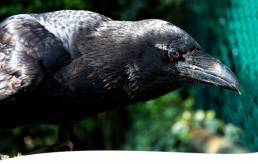
Raven
Ravens are a member of the corvid family. They are super intelligent (about the same intelligence as a 5 year old child).
LATIN NAME: Corvus corax
DISTRIBUTION: North America, Asia, Europe, North Africa
HABITAT: Varied but tend to prefer wooded areas, especially along coast and mountains
DIET: Omnivorous, this includes insects, seeds, berries, carrion, eggs, young birds and occasionally small mammals
WINGSPAN: 120–150cm
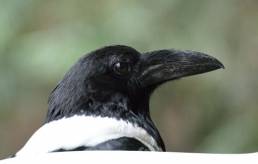
Pied Crow
Pied Crows are often seen feeding at carcasses with Vultures. These cheeky crows take the smaller pieces discarded by the Vultures and pick the bones clean.
LATIN NAME: Corvus albus
DISTRIBUTION: Africa
HABITAT: Varied – open dry country, semi-desert and grassland
DIET: Omnivorous, this includes insects, seeds, berries, carrion, eggs, young birds and occasionally small mammals
WINGSPAN: 85–98cm
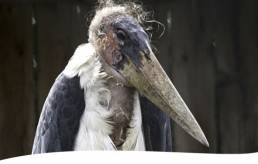
Marabou Stork
The Marabou Stork is sometimes called the undertaker bird.
LATIN NAME: Leptoptilos crumeniferus
DISTRIBUTION: Sub-Saharan Africa
HABITAT: Dry, open savannah near large lakes or rivers
DIET: Extremely varied from insects to fish, eggs, birds and rodents, frequent scavenger
WINGSPAN: Up to 300cm
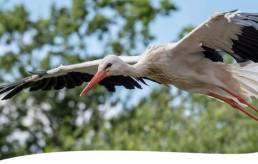
White Stork
The White Stork is a migratory bird leaving Europe when it gets cold for warmer climates in Africa!
LATIN NAME: Ciconia ciconia
DISTRIBUTION: Europe and Africa
HABITAT: Open habitats of wet pastures, marshes and shallow lakes
DIET: Varied including insects, frogs, fish, snakes, lizards and mice, will also scavenge
WINGSPAN: 155–215cm
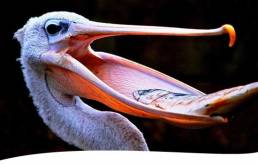
Pink-backed Pelican
Pelican’s beaks can hold up to 8 litres of water.
LATIN NAME: Pelecanus rufescens
DISTRIBUTION: Southern Asia, Africa, and southern India
HABITAT: Swamps and wetlands
DIET: Mainly fish, also amphibians
WINGSPAN: 209–215cm

Crested Caracara
The Crested Caracara is sometimes known as the ‘Mexican Eagle’.
LATIN NAME: Caracara cheriway
DISTRIBUTION: Central and southern America
HABITAT: Wide ranging, typically open and semi-open country
DIET: Mainly opportunist scavenger, carrion and also immobile, slowing-moving or injured prey
WINGSPAN: 105–135cm
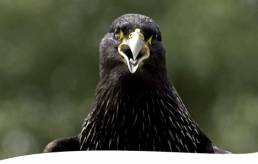
Striated Caracara
The Striated Caracara is also called “Forsters Caracara” or “Johnny Rook”.
LATIN NAME: Phalcoboenus australis
DISTRIBUTION: Falkland Islands, Southern tip of South America
HABITAT: Rocky coasts
DIET: Mainly opportunist scavenger, carrion and also immobile, slowing-moving or injured prey
WINGSPAN: 115–125cm
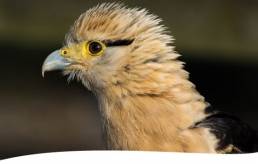
Yellow-headed Caracara
LATIN NAME: Milvago chimachima
DISTRIBUTION: South America
HABITAT: Savannah, scrub and forest
DIET: Varied. Amphibians, reptiles, insects, fruit and carrion
WINGSPAN: 80–95cm
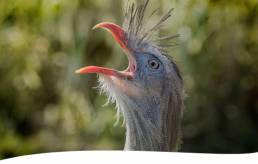
Red-legged Seriema
Red Legged Seriema have a very loud alarm call that can be heard from miles away.
LATIN NAME: Cariama cristata
DISTRIBUTION: South America
HABITAT: Grasslands and open scrub
DIET: Diverse – Insects, worms, small mammals, frogs, snakes, lizards, also fruit, seeds and other plant material
WINGSPAN: Up to 100cm

Secretary Bird
Secretary Birds have incredible force in their legs, they use their feet to ‘stomp’ on their prey to kill them.
LATIN NAME: Sagittarius serpentarius
DISTRIBUTION: Africa
HABITAT: Open savannas and grasslands
DIET: Large variety including lizards, insects, snakes, mice and larger mammals
WINGSPAN: 191–215cm

